Fitness has been an issue for Luke Thomas since the start of the season. The England U21 left-back has had a bit of a stop-start season thus far, having played (and started) in eight games for Leicester in all competitions this term. When fit, he’s likely a starter — potentially even in with a chance of a senior England call-up; Luke Shaw and Ben Chilwell currently have a bit of a stranglehold on that position, whilst Bukayo Saka could see himself thrown in there too, though that’s obviously not his best position, and if Shaw or Chilwell suffer injury or a drop in form, Thomas is in the conversation for the next best option at left-back.
This isn’t a case of default either, there are good options across the Premier League. Brentford’s Rico Henry has made the transition to the top division seamlessly, though Aston Villa have struggled Matt Targett has still been consistently good for them over the past few seasons, and West Ham’s Aaron Cresswell has been an outstanding presence on their left-flank, albeit he turns 32 this December and Gareth Southgate may not see an international future with him. Thomas, on the other hand, is only 20 and when playing, has shone at times this season.
He is an incredibly confident and direct attacking full-back, who has shown an ability to play in a variety of formations at both Leicester and with the U21 set-up for England. This tactical analysis and scout report will provide an analysis of Luke Thomas’ strengths as an individual, whilst looking at how he plays right now with the tactics of Leicester City.
Positioning
Thomas has had experience playing as a left wing-back and as an orthodox left-back in almost equal amount this season. Brendan Rodgers has had Leicester lining up in a variety of formations throughout the season already, switching between a back three with wing-backs either side, of course, and then the standard back four. We can see Leicester’s most used formations this season in the following image, with a 4-4-2 preferred, but a 3-4-1-2 and 4-2-3-1 used on a number of occasions too. Rodgers has also often switched formations mid-game, seeing Thomas playing first as a left-back and then as a wing-back, or vice-versa.
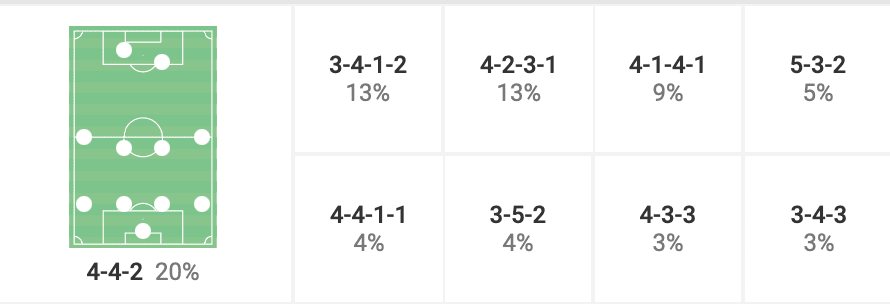
Looking at Thomas’ heat map from this current season, we can firstly see that he plays a very active role both in deeper areas in build-up play and in attacks, with his heat map stretching down the entirety of the left flank. What’s interesting is that there’s a fair amount of action in narrower positions too, and we will look at this in more detail as this section of the analysis progresses. However, one thing that is evident when watching Thomas is just how disciplined he is, positionally. This is throughout the game — in transitions, the attacking phase or defensive phase — and frankly, this same discipline that’s seen in the defensive part of his game likely goes some way to explaining his outstanding defensive output. He doesn’t have tendencies positionally per se, as he can vary his approach based entirely on the tactics at the time.
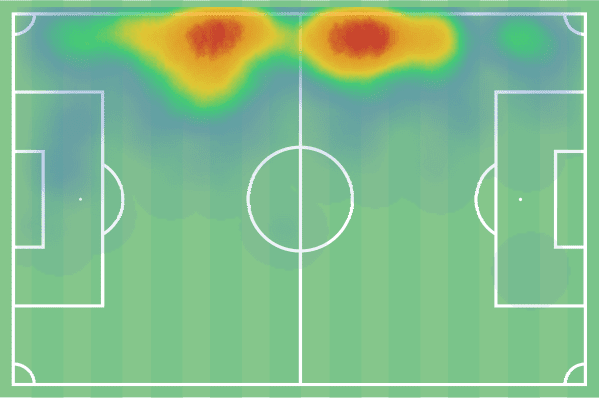
For example, when playing with England U21, Thomas still pushes high down the left flank but tends to stick to wider positions. He can play as a classic high positioned wing-back in possession, pushing far down the left-flank and consistently providing an option for his teammates to find with a through pass, like in the next image. He can make runs in behind from this position, always providing a pass outlet. However, this high positioning also stretches the opposition backline and facilitates the creation of space in central positions too.
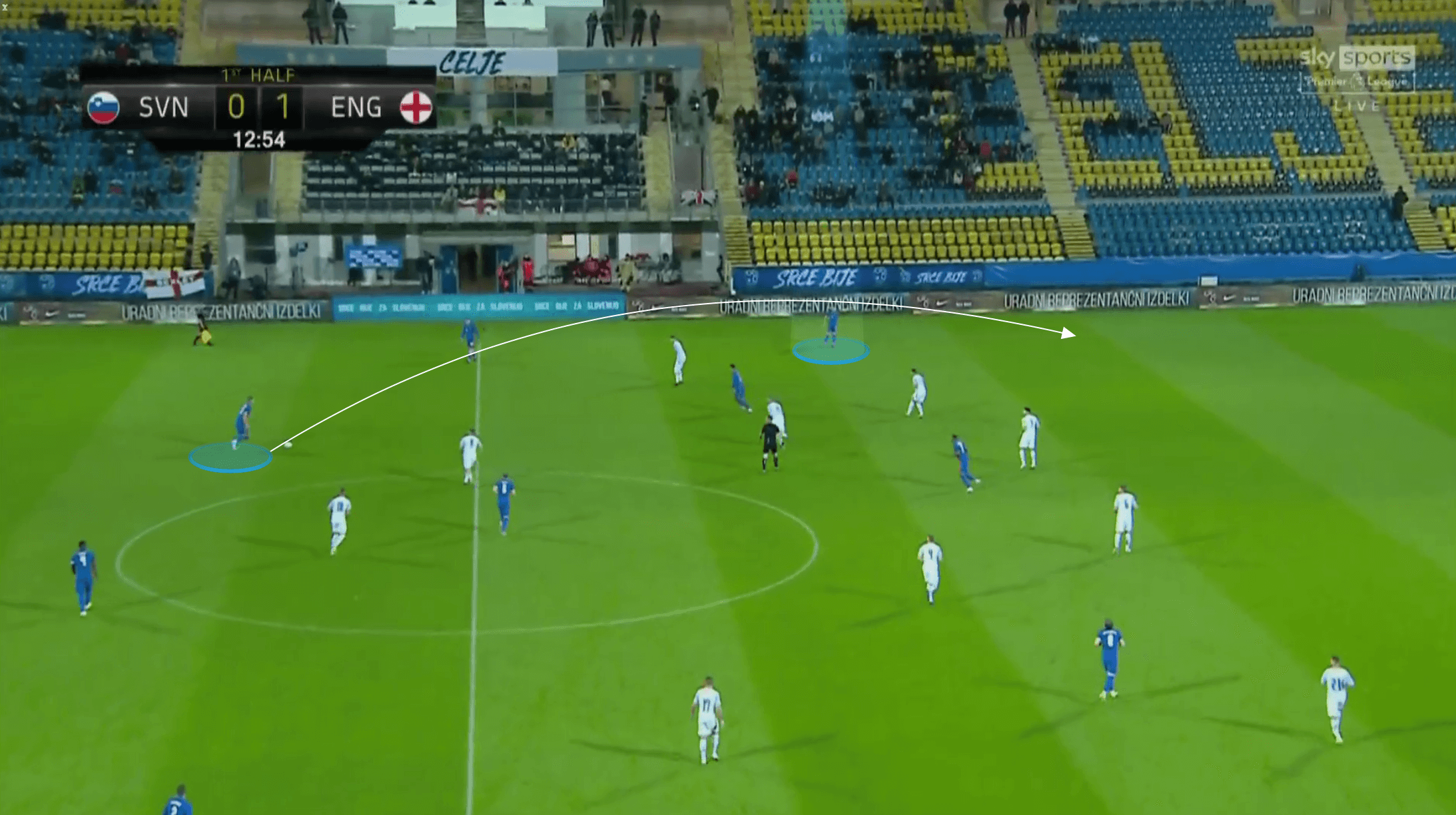
Thomas will drift well into the central channel in the possession phase for Leicester. He is comfortable receiving and picking forward passes from this area and whilst he isn’t exactly João Cancelo at Manchester City with this kind of positioning, he nevertheless still gets on the ball frequently in this area, leaving his left-flank entirely bare when operating as a wing-back. Thomas will even take on shots from distance when receiving in such a position, and whilst he hasn’t developed into a consistent goal threat thus far, he does strike the ball with excellent technique, power and moderate accuracy from long range.
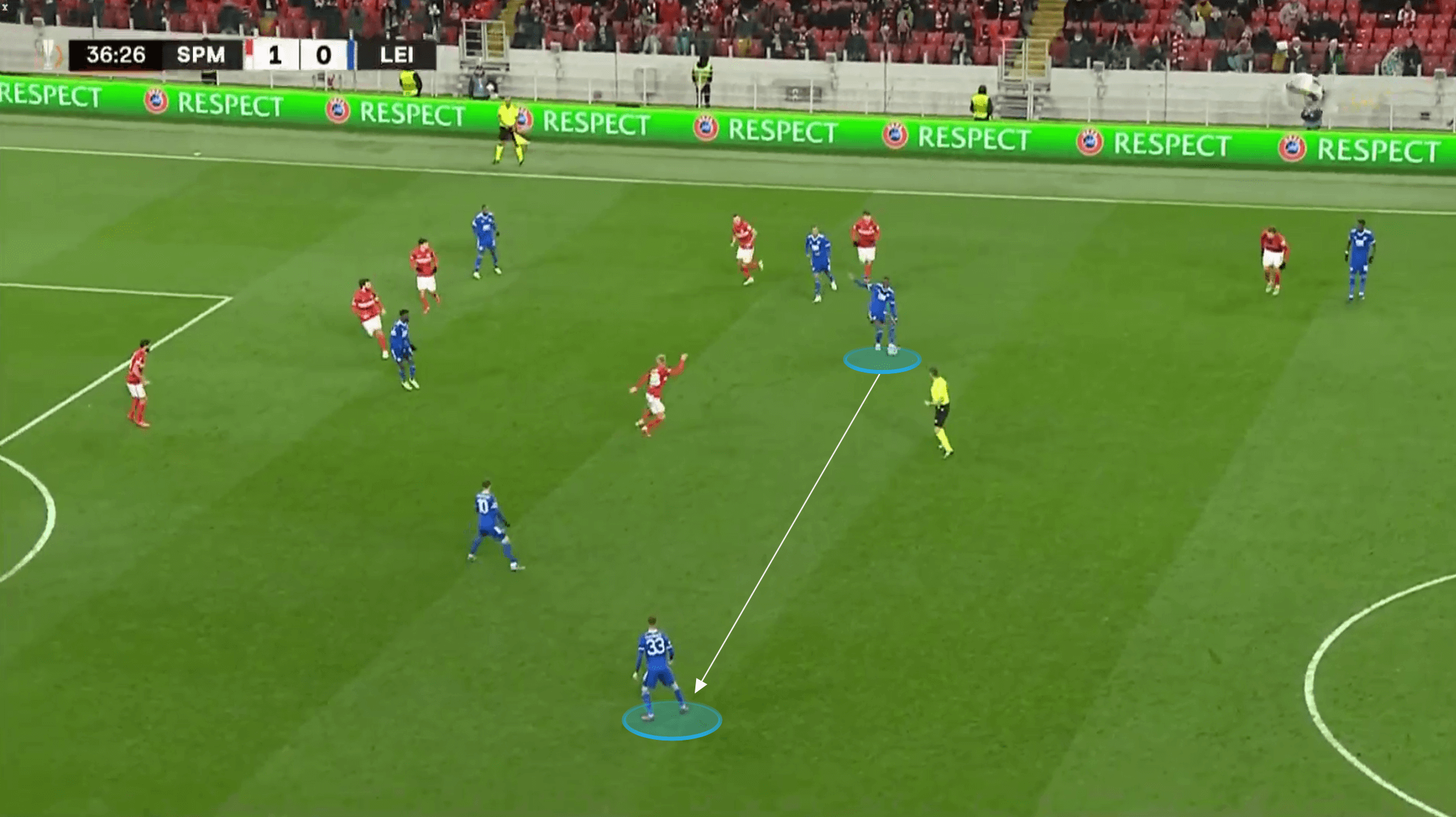
He can restrict himself at times with this narrow positioning, however, none more so than when looking to receive in and around the 18-yard box. Thomas pushes far up the pitch and is regularly in the kind of position seen in the following image.
In this example, he looked to receive in the space he is currently in. He’s on the half-turn and aware of the nearest defender’s positioning. Yet were he to shift wider more quickly than he does, gaining 3-5 yards more, he could either receive the ball in more space to feet, further away from the nearest defender or if that defender were dragged out wider from this movement, then Thomas could have latched onto a split-pass in the space behind.
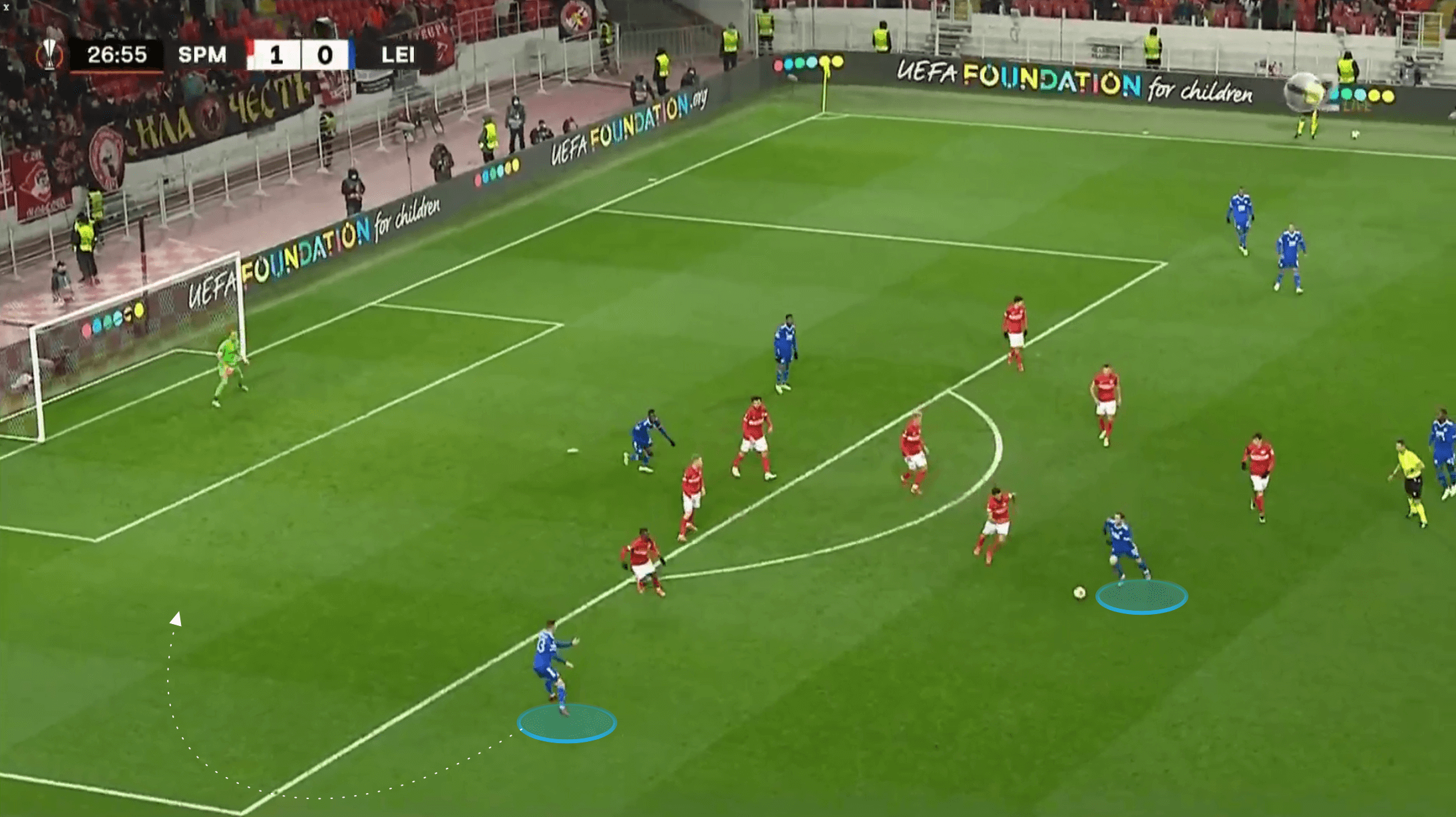
However, this narrow positioning can open up attacking opportunities, and Thomas should have scored in the recent 2-0 loss against Arsenal with a chance forged by this.
Admittedly, in the next image, there is a Leicester player out on the left wing and with Boubakary Soumaré on the ball, Thomas underlaps into an advanced position on the corner of the 18-yard box.
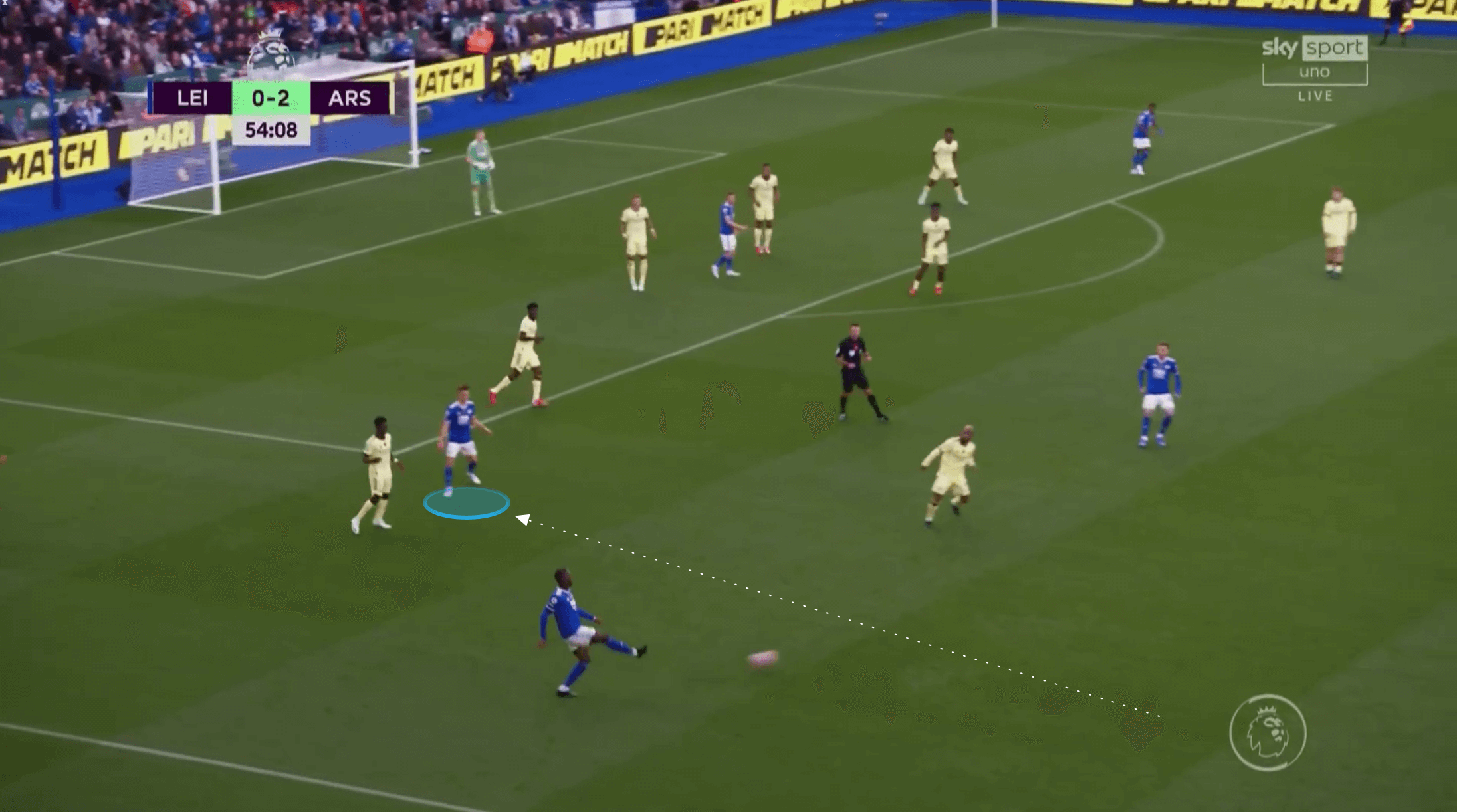
As the ball is circled inside in this instance, Thomas is able to ghost off of the shoulder of his marker and receive the ball through the gap of the Arsenal defence. Turning and shooting from this area, he minimally missed the far post. However, this was a 0.19xG chance, a high-quality chance, and was possible through him rotating into this forward, narrow position.
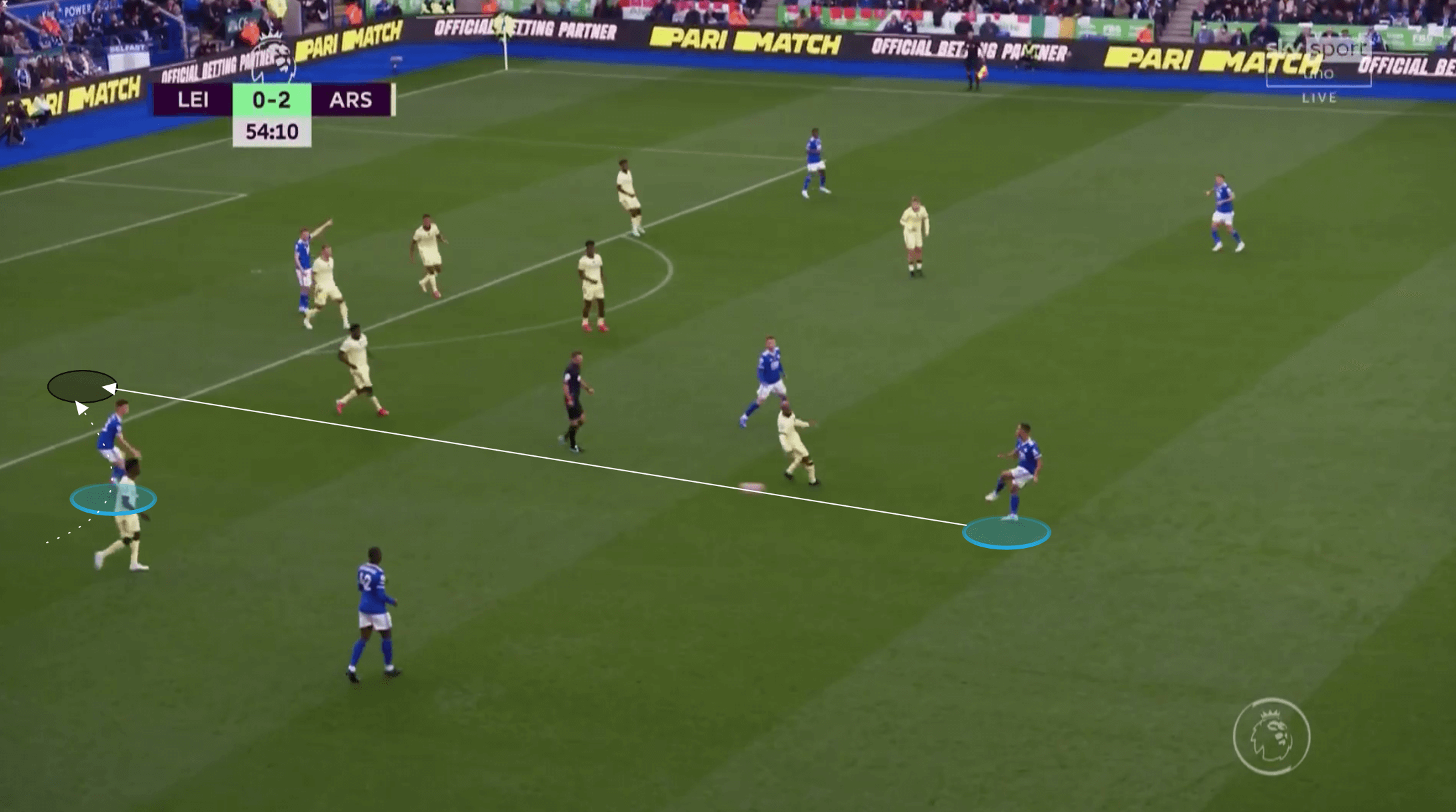
Thomas can take this kind of position in less developed attacks too. Against Spartak Moscow in Leicester’s Europa League game against them this season, Thomas’ positioning was relatively interchangeable with that of the central midfielders and forwards. In the next image, he pushes into the front three with forward Kelechi Iheanacho dropping into the left wing-back position.
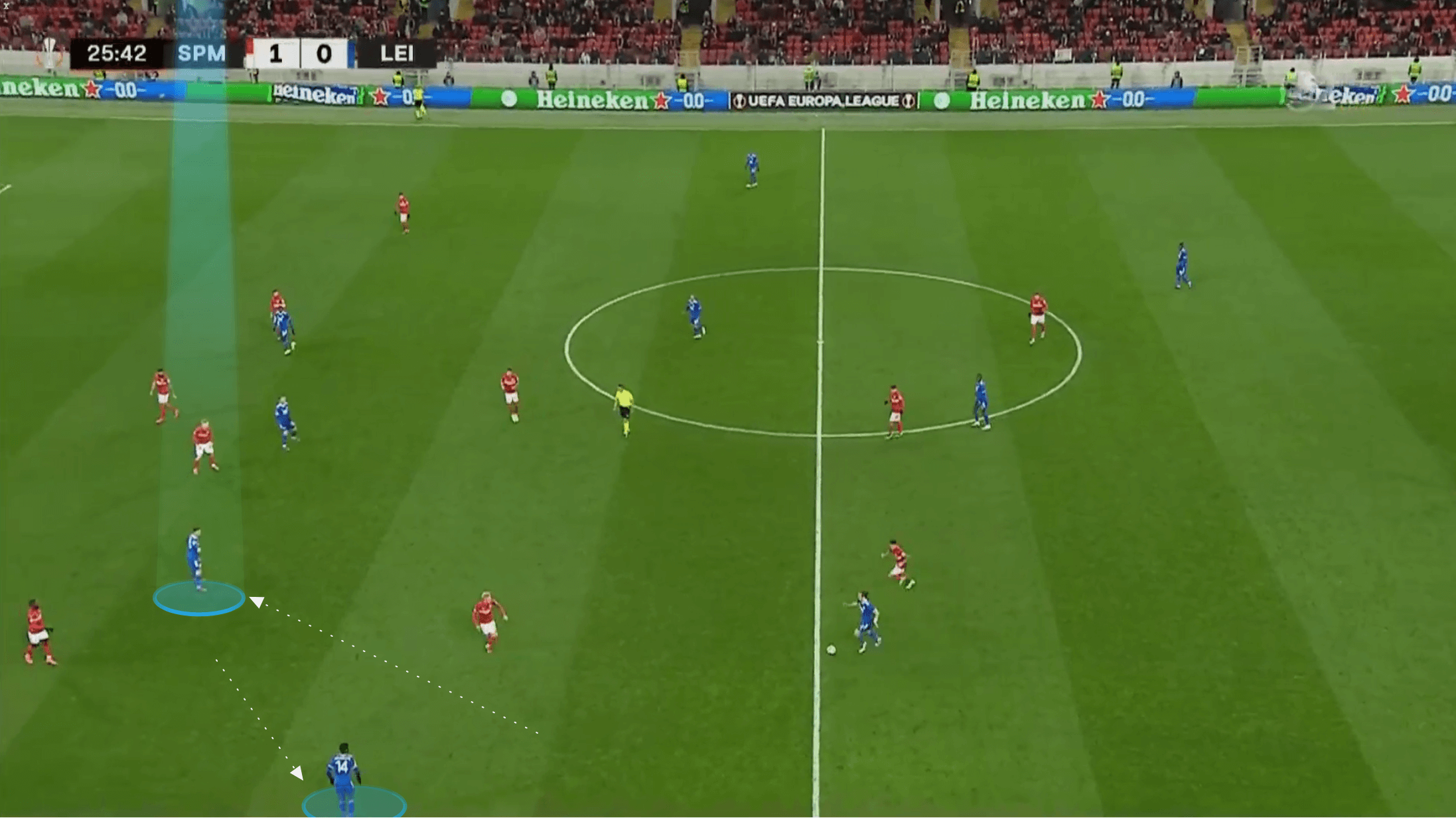
In possession
Over the next two sections, there will be several data scatter graphs, showing Thomas’ performance in context against that of the rest of the U21 left-backs who have played 500 minutes or more over the past 12 months in Europe’s top five leagues (Premier League, La Liga, Bundesliga, Serie A, Ligue 1). The first graph will show Thomas’ performance when delivering from wide areas. Looking at the graph we can see he has performed below the average over the past 12 months for this metric, with 1.389 crosses per 90, representing a volume well below that average, on top of a 25.04% completion.
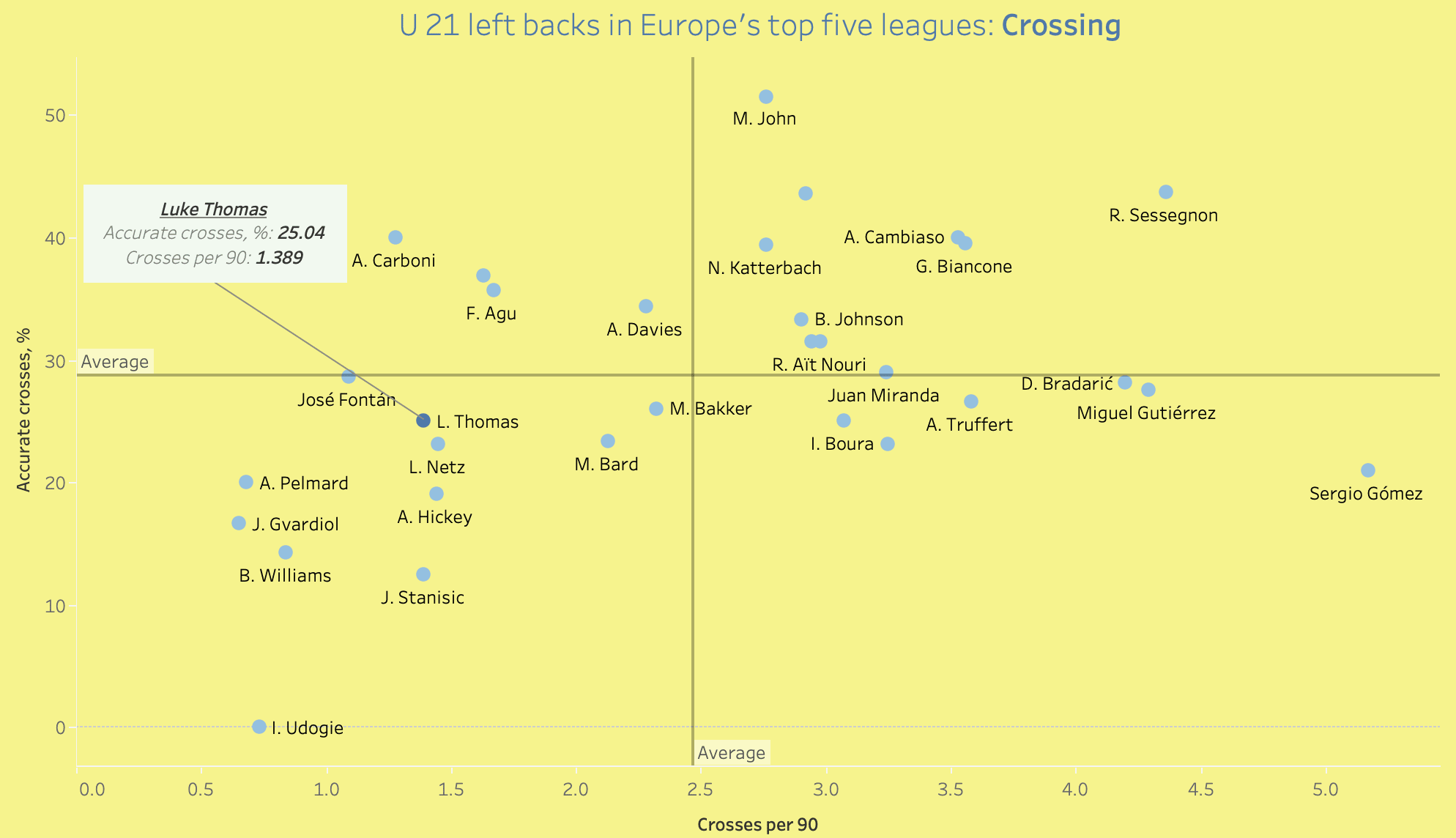
Crossing is an issue of concern for Thomas and one area that certainly needs developing in his game. Looking at a smaller data set than the one shown in the previous image, we can look at the number of crosses he has taken this season. He has made a total of just 17 crosses in the 8 games he has played for Leicester thus far this season, which when averaging out his minutes on a per 90 basis, has him making just 1.99 per 90 – not an overly high amount but admittedly higher than his average over the past 12 months. Yet he has completed just two of these crosses, leaving him with a rather woeful 11.9% completion in all competitions this season.
When looking at Thomas’ deliveries from this season, it isn’t as disastrous as these statistics may suggest. He has a habit of rushing a cross, which is causing some issues in terms of accuracy. If the ball isn’t under control e.g it’s bobbling on the surface or he’s sprinting to recover the ball before it goes out of play – he can struggle to get good purchase on the ball with these efforts often soaring out of play or tamely arriving into the grasp of the grateful goalkeeper.
He can also attempt many crosses when an opposition defender is in close proximity and these aren’t always the best decision, with the ball either being blocked or with Thomas lacking the room to be able to direct the ball into the preferred area.
However, when he has more time and space to deliver, Thomas is putting the balls into good areas, even if they don’t always reach their target. He can whip the ball into the box with pace and good direction.
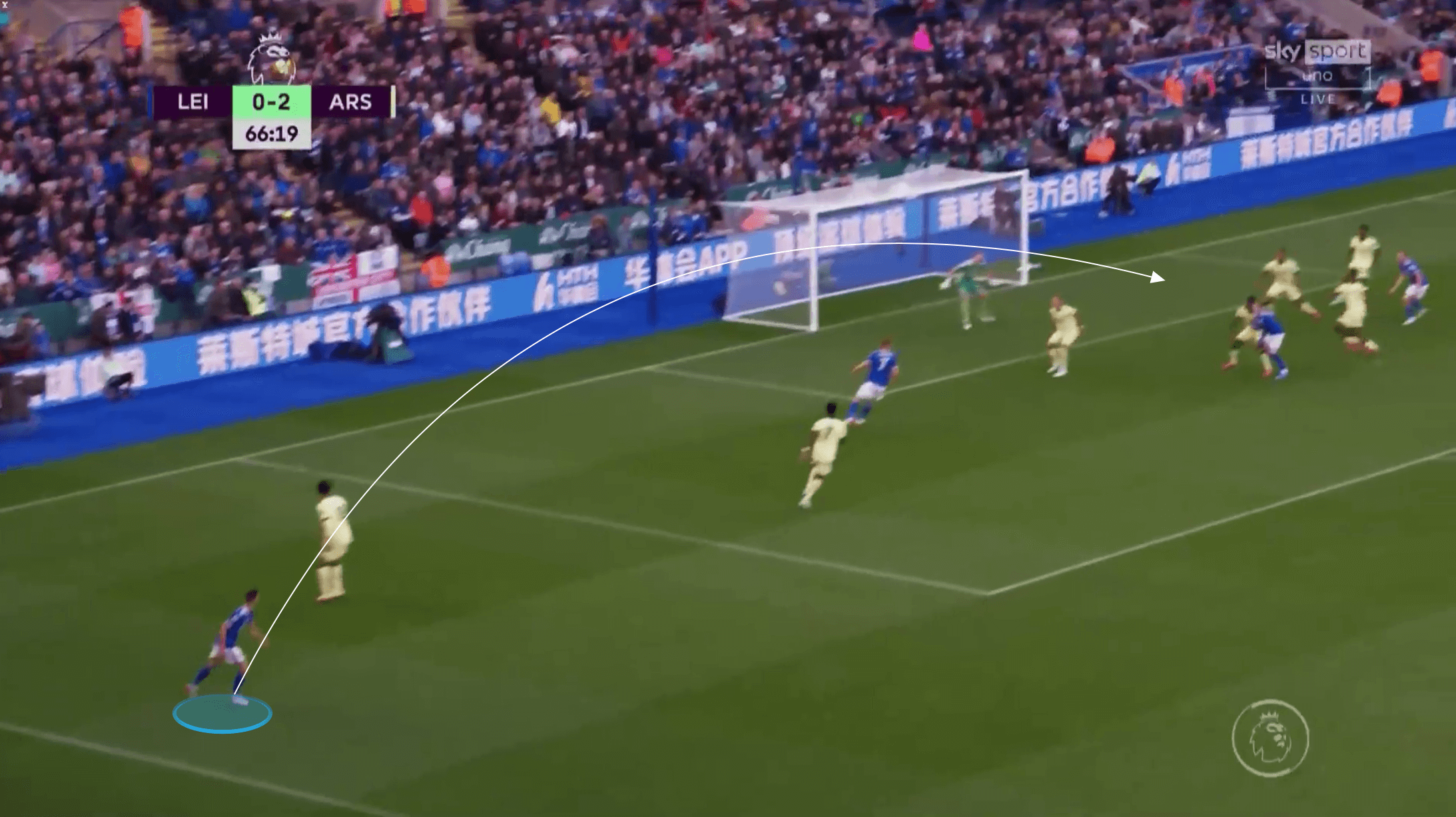
With him often drifting into the narrower positions highlighted in the previous section, he is naturally going to take fewer crosses as a result. Yet whilst Thomas isn’t a prolific creator, he does have an eye for a through pass and on the occasion that he makes these passes, he can execute them perfectly with outstanding vision and weight of pass.
We can see such an example of a through pass coming from Thomas in a narrow position in the following image.
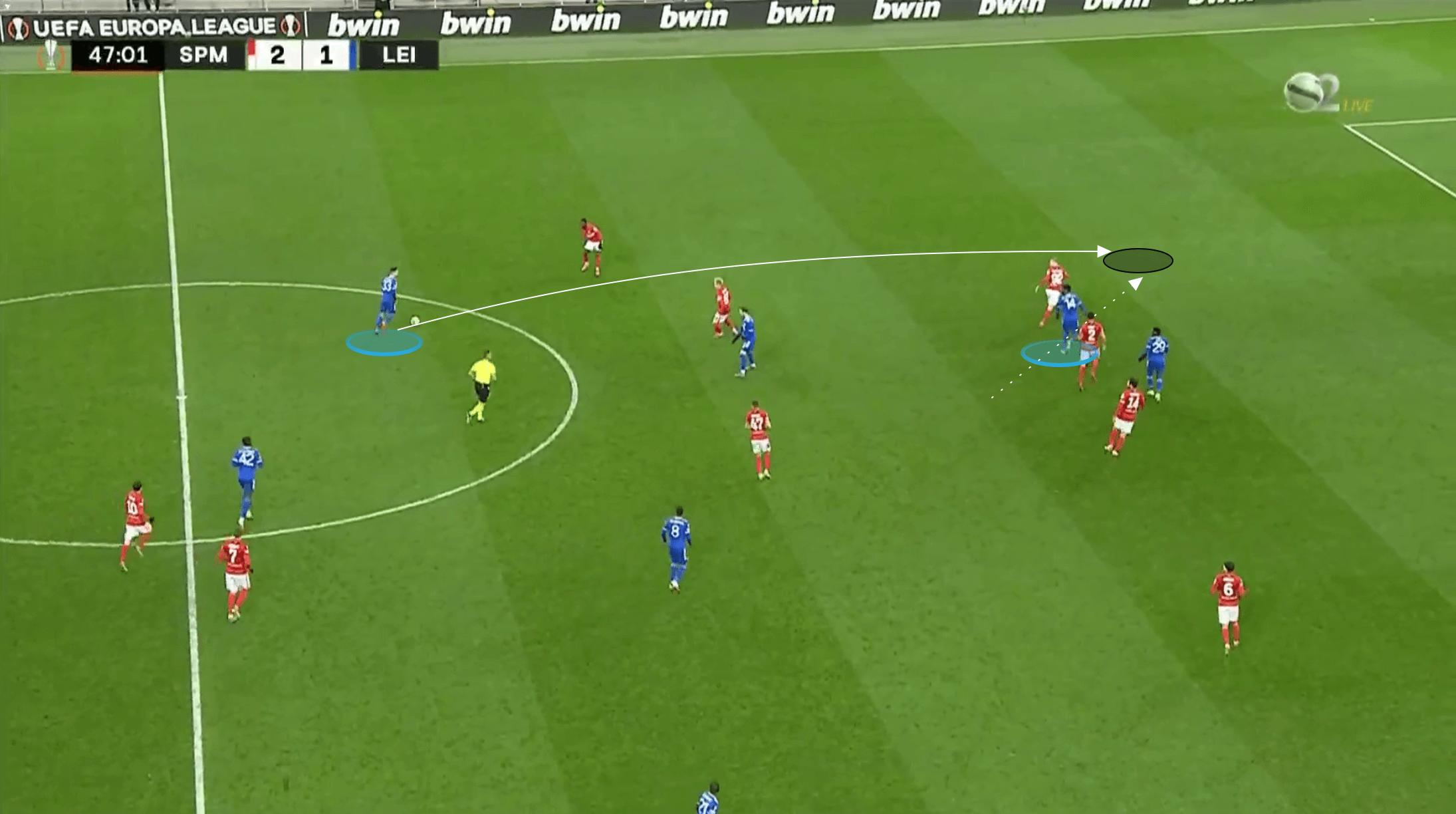
Thomas is minimally better as a dribbler. His 50.09% completion over the past 12 months is minimally below the average among his U21 peers, as is his 3.045 dribbles per 90.
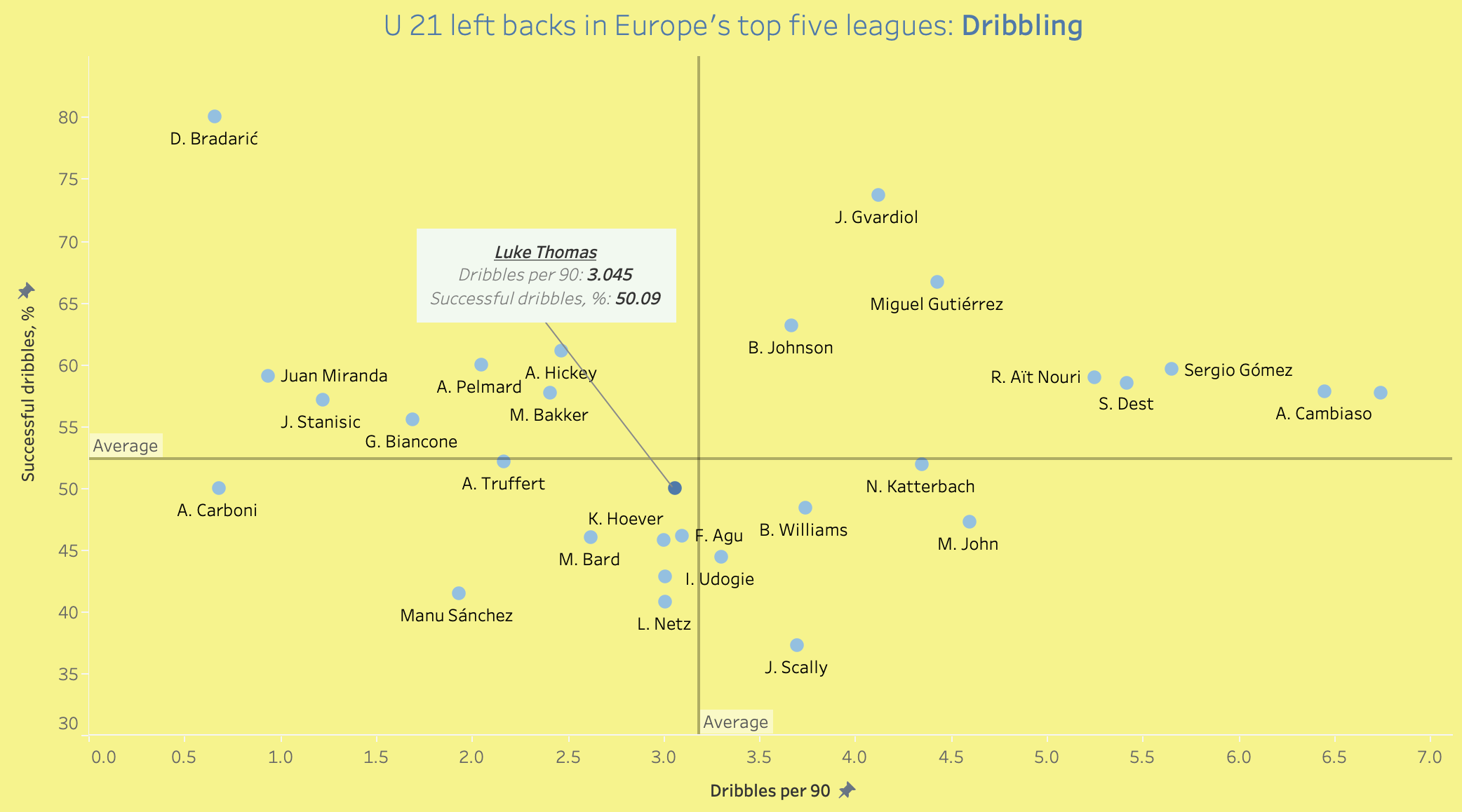
Thomas completes a lot of his dribbles with quick touches to the side before making a pass or a cross. He doesn’t tend to go on long mazy runs but mainly uses his dribble to either evade pressure in the build-up phase or to quickly skip past the opposition right-back when operating out wide in the final third — and he’s often successful when doing so. He can cut inside, not always sticking to his favoured left-foot, and has a sharp turn of pace over 5-10 yards.
However, he needs to be more aggressive on the ball. There are times when Thomas has the space in front of him to drive at full tilt and to progress the ball himself. This lack of aggression can be seen in some of his unsuccessful dribbles where he doesn’t impose himself on the defender, rather, delaying his dribble and allowing them to get into a better defensive position and dictate the duel.
Such an example can be seen in the next two images from the Europa League game against Legia Warsaw. When looking to play past Legia’s press, Leicester circle the ball out wide to Thomas who is narrow and deep. In this moment, he has an excellent opportunity to drive forward and take the space in front of him.
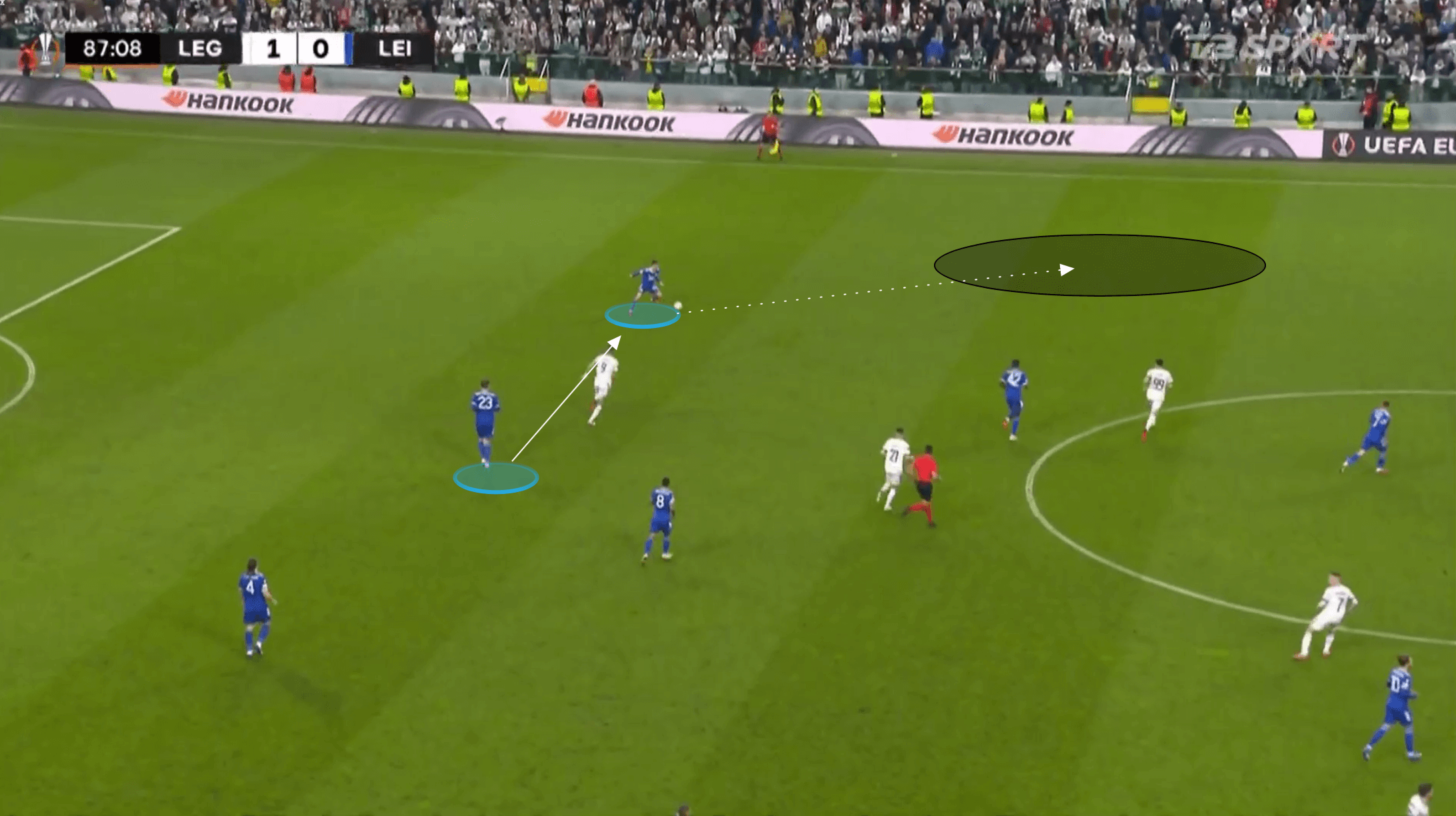
However, instead of instantly doing this and aggressively driving forward, Thomas dithered on the ball and allowed the pressing forward to gain space on him, on top of allowing the midfielder in front of him to shift across the pitch and cover the space, where the opportunity to break forward had now gone.
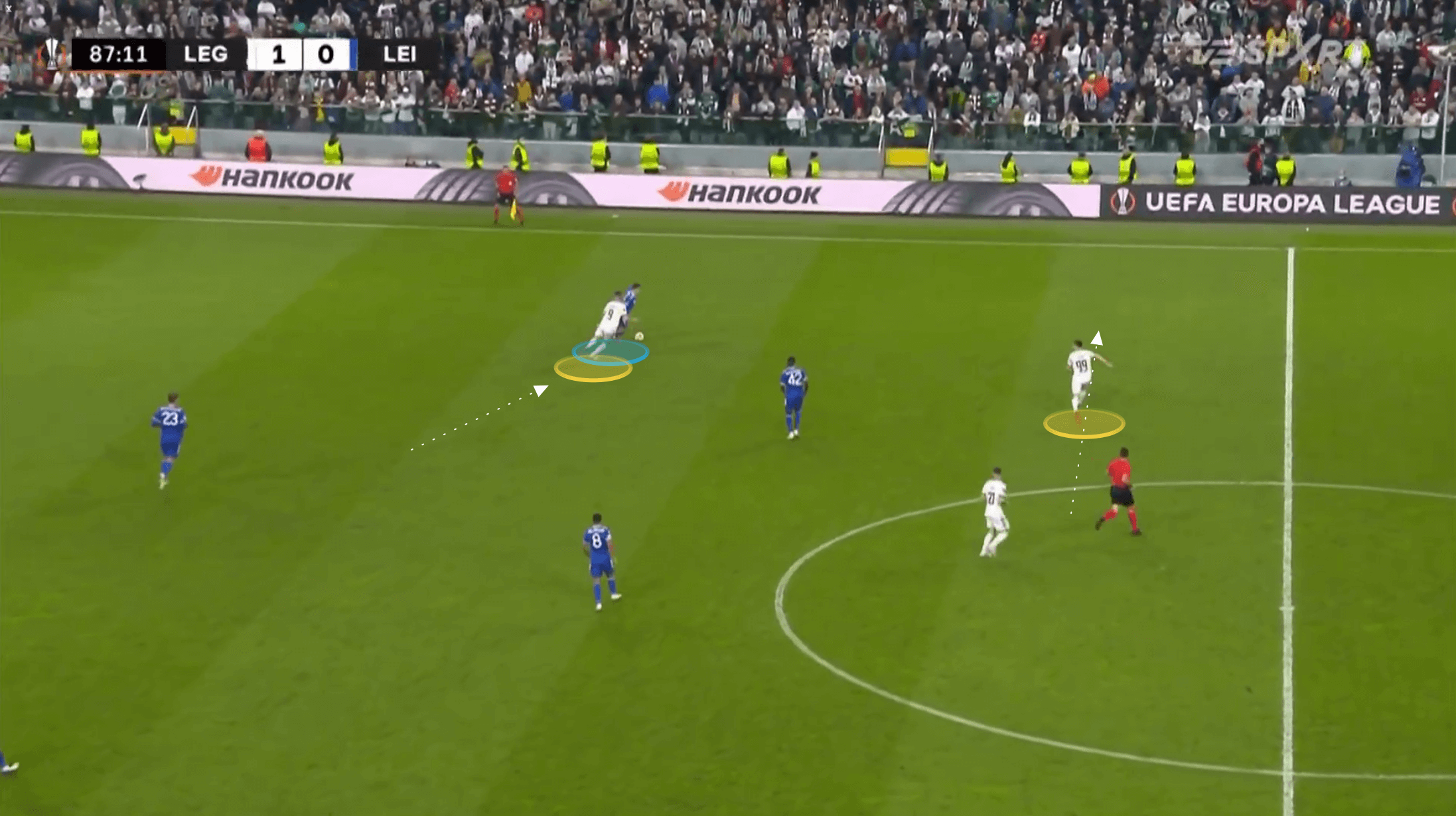
Defensive work
Thomas performs far better in the defensive phase and the following scatter graphs will show just how much he excels.
Standing at 1.81m in height, Thomas isn’t overly tall but has decent height for a full-back. This certainly helps him aerially. However, he also shows good timing and bravery to compete. Frankly, there are few defenders in the data set performing at a better rate aerially than Thomas. With him competing in 3.498 aerial duels per 90 over the past 12 months, he has been involved in a number far higher than the league average. Yet, his 48.39% completion is respectable. It is higher than the league average, and there are only two left-backs, Joško Gvardiol and Giulian Biancone (who is a right-back that has merely filled in at left-back), who have competed in a higher volume and managed a higher completion than Thomas.
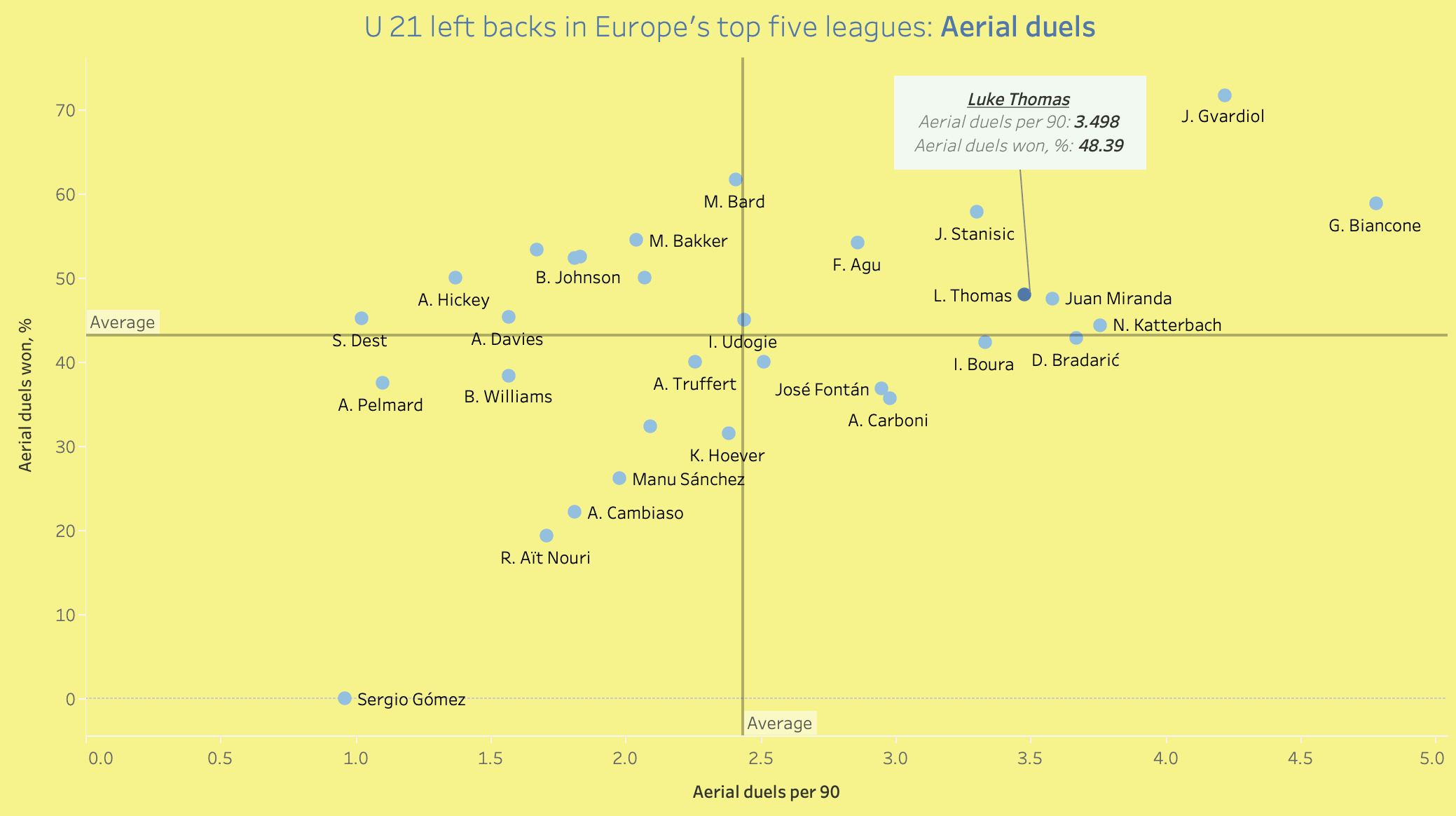
Thomas is also exceptional when it comes to making interceptions and blocks. Firstly, in the case of the latter, the 0.278 shots blocked per 90 isn’t a particularly high number but when we see it in relation to the rest of the data set, we can see that he is making more than most of his U21 peers. Andrea Carboni is the outlier in this graph but the Italian defender has spent the vast majority of his minutes at centre-back where he is naturally going to make more blocks. Yet, it is in possession adjusted interceptions where Thomas truly stands out. His 7.413 pAdj interceptions is outstanding, with only a couple of full-backs managing more than this amount.
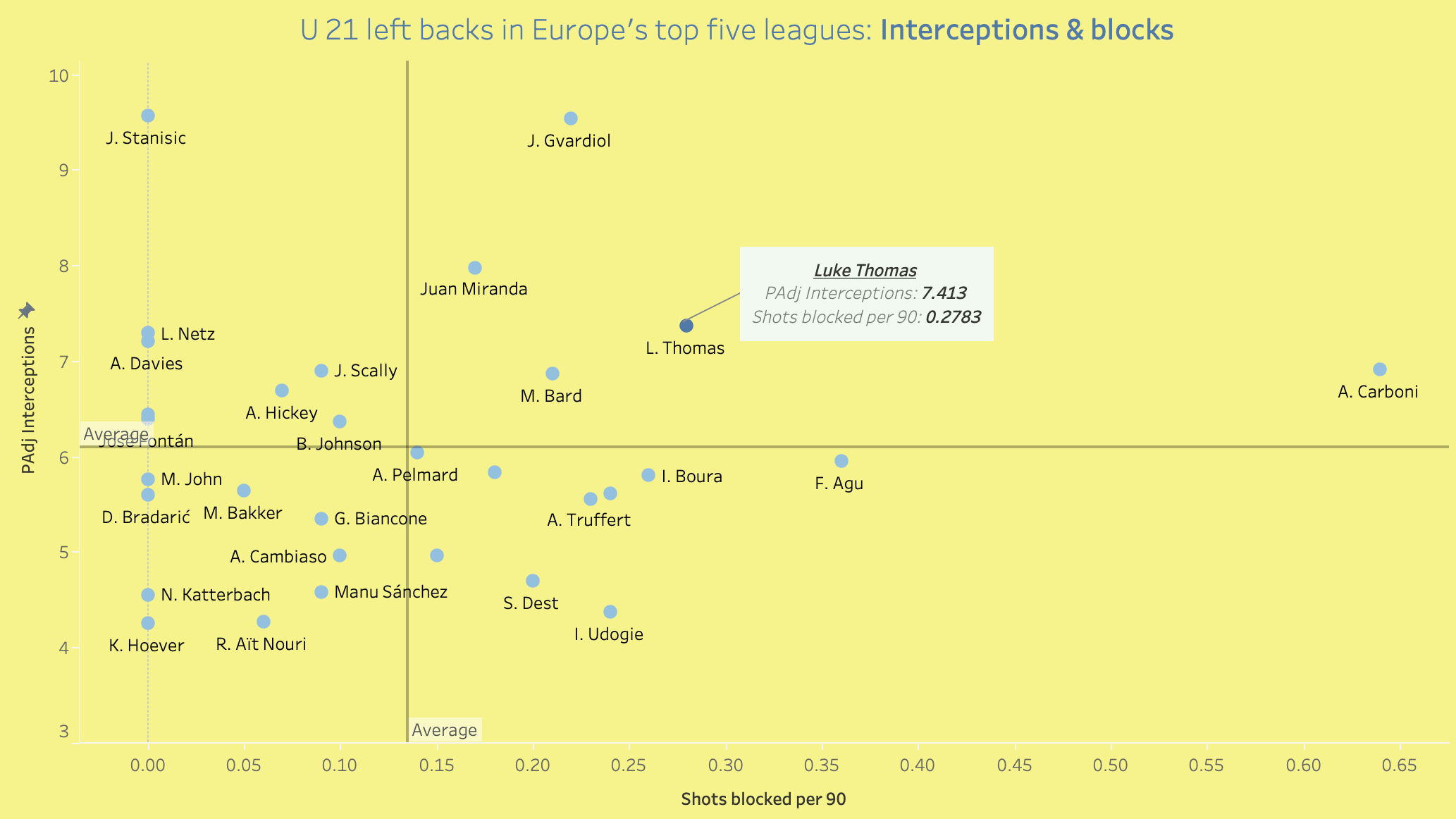
Thomas isn’t overly proactive with his positioning and ability to cover spaces in the backline, yet his reaction is of the highest quality. Thomas recognises a loss of possession, for example, and instantly springs into action, dropping back into shape where he can often cut out a pass, cross, or long ball played in behind. He is aggressive in stepping out of the backline too and he will follow his opposite number well inside the opposition half during their possession phase. He is quick and combative and can outmanoeuvre the opponent to get to the ball first or at the very least stick out a leg to poke it away from their control.
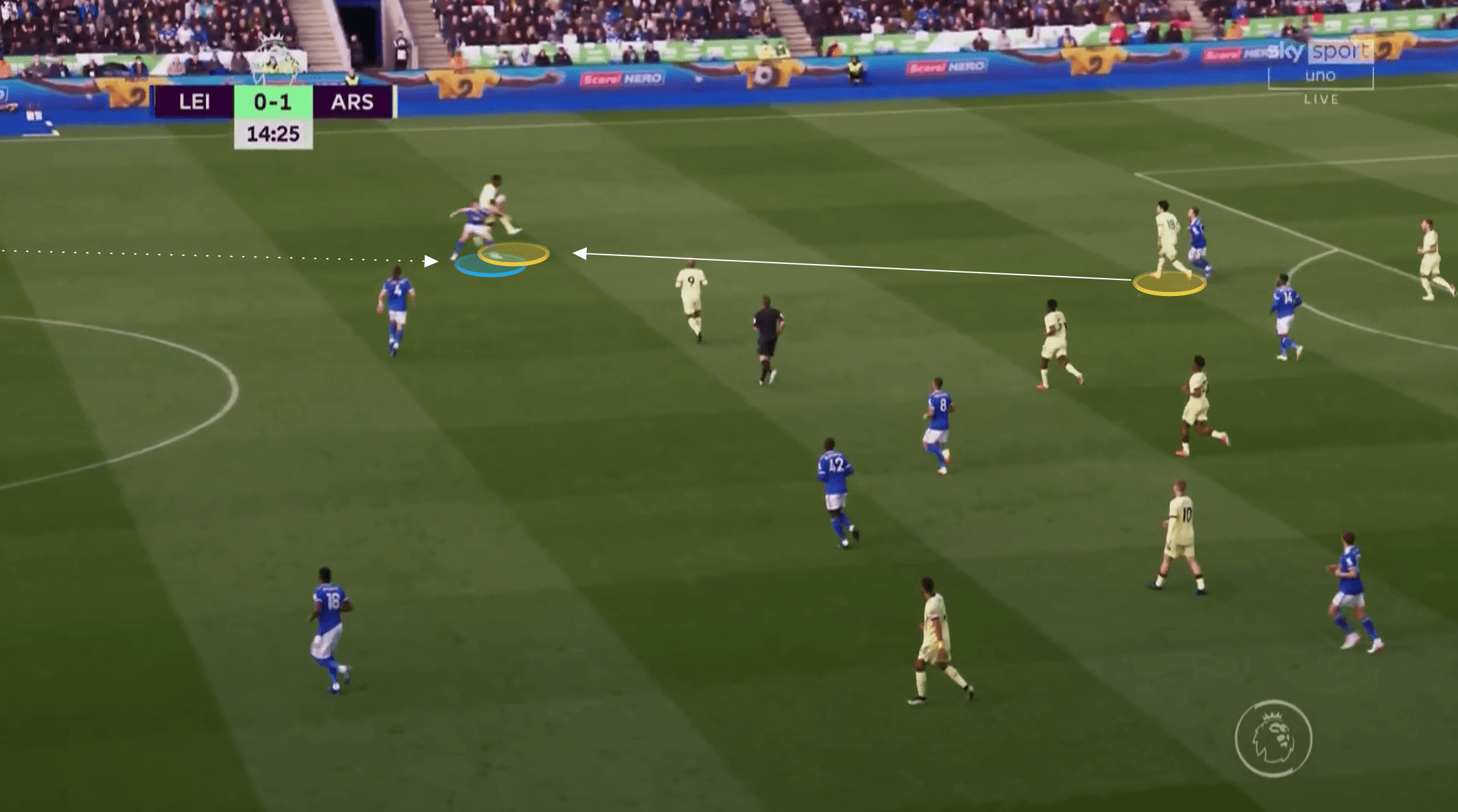
This reaction time is seen when he competes in defensive duels, in general. Thomas has a quality acceleration and exceptional top speed. This can be seen in the following example where England U21 were playing Slovenia U21. We can see Thomas’ positioning as the ball is lost in the central channel.
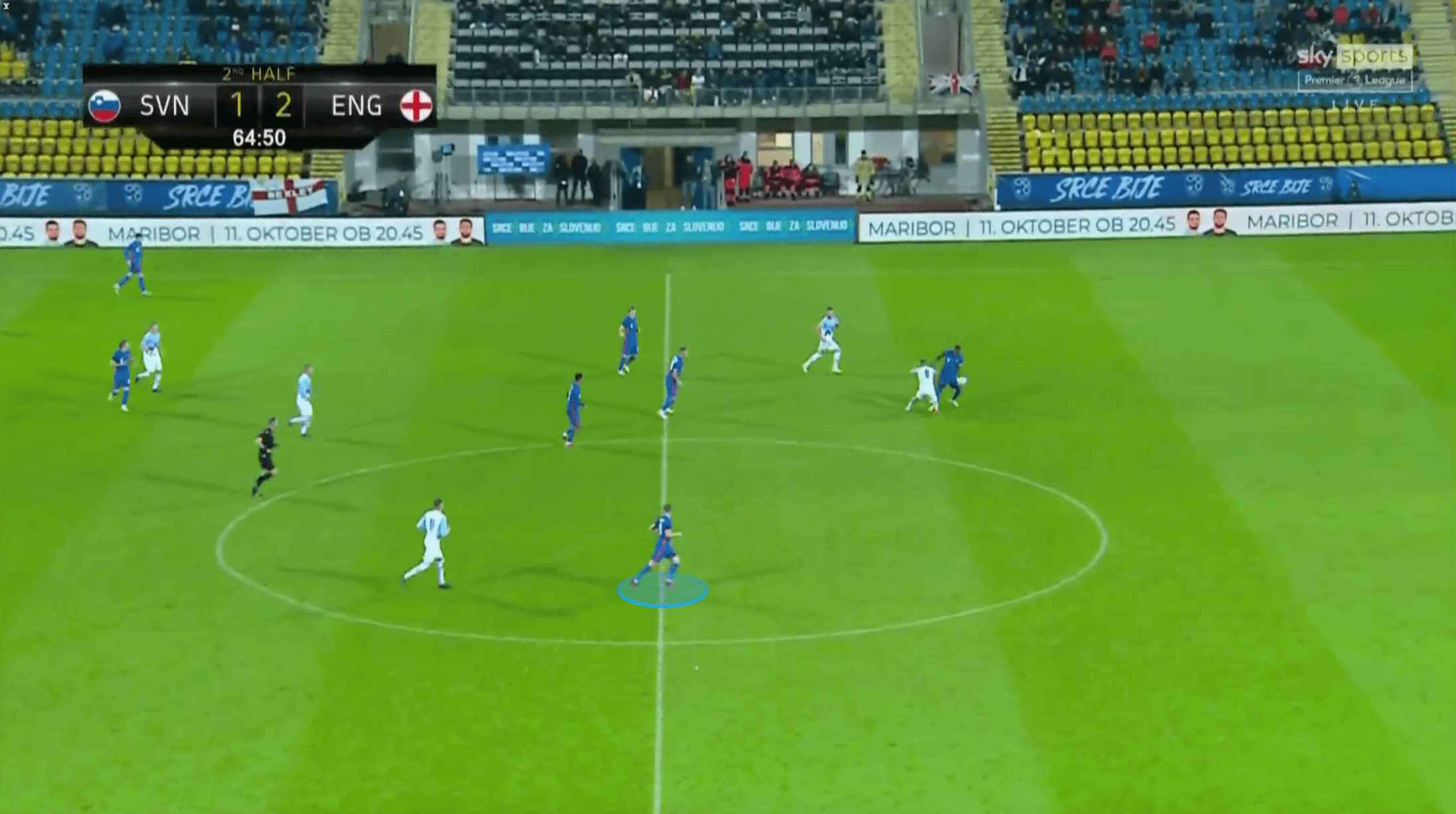
Thomas is able to come from this wider position, bypassing everyone on the pitch, and cutting across the opposition to delay the attack and prevent the goal on the counter.
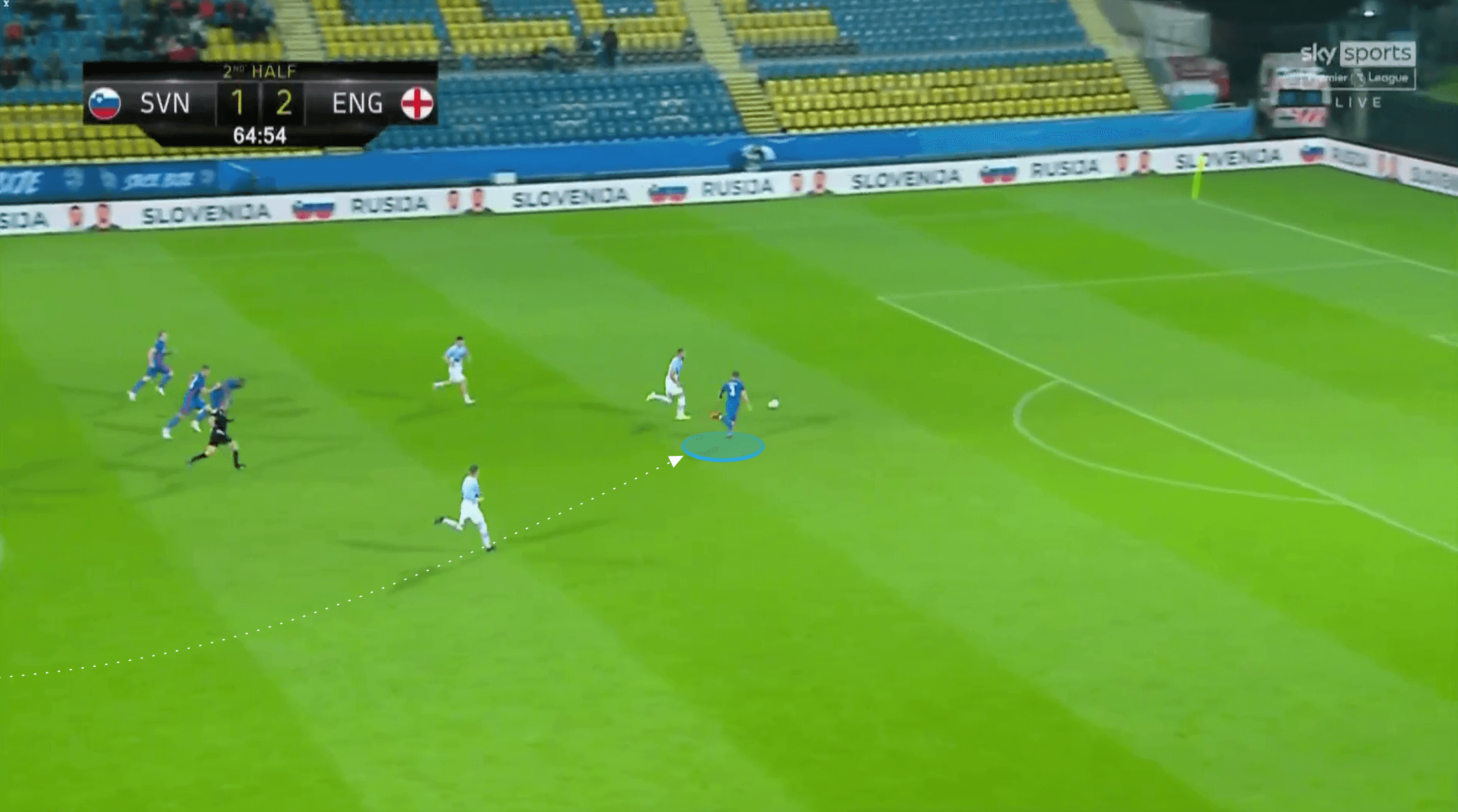
Looking at his performance in defensive duels, we can see in the next image how his 7.939 defensive duels per 90 is bang on the average for the u21 left-backs in Europe’s top five leagues. However, we can also see that his 71.96% win rate, which is a very high percentage, is the highest in the entire data set.
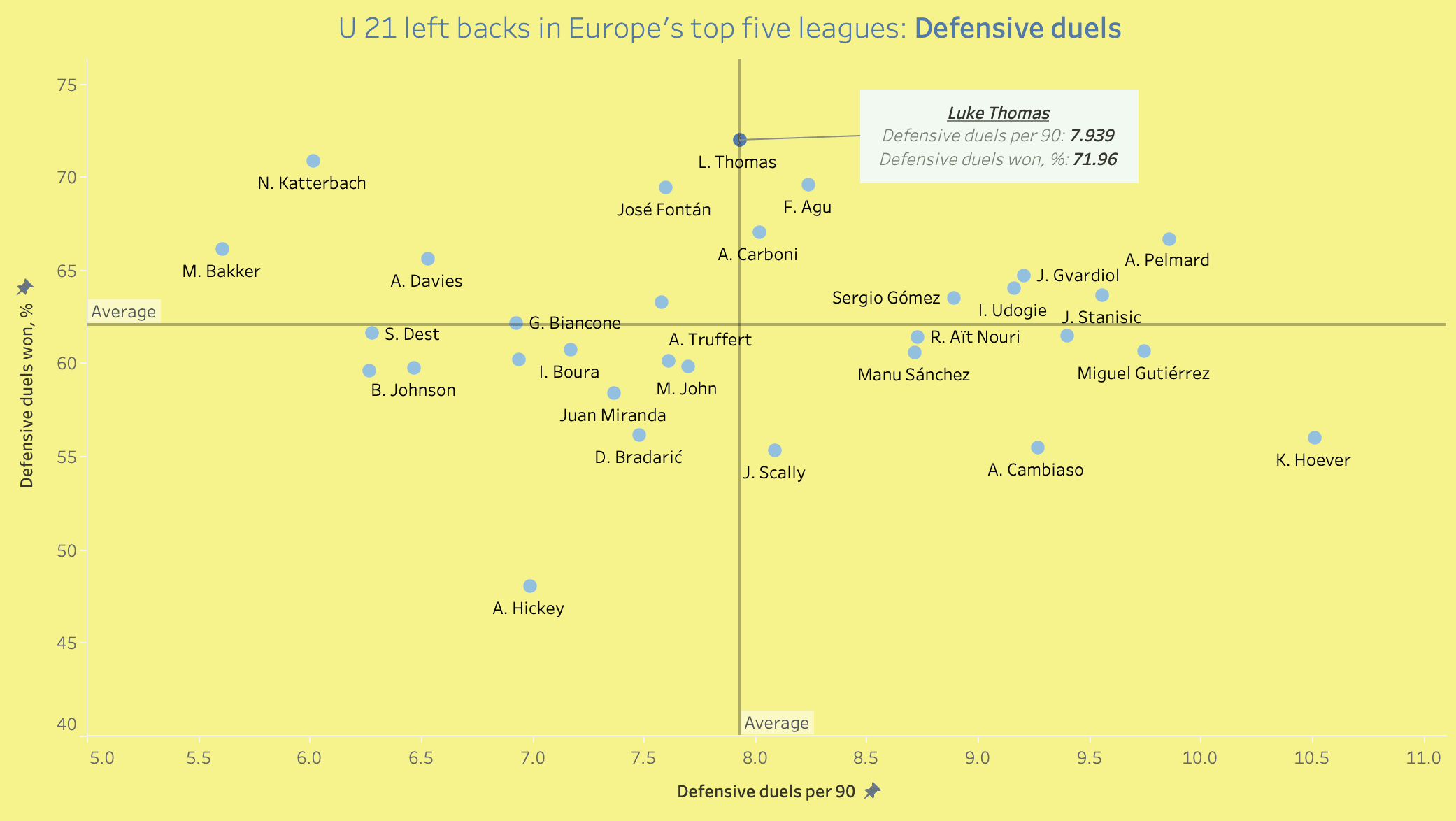
Thomas is an outstanding defender in 1v1 duels. His timing on tackles is exceptional. He closes the space quickly and can beat players for pace if they look to knock the ball past him. He doesn’t dive in and waits for the opponent to show a fraction too much of the ball to him before stepping in.
He has a habit of turning but leaving his left foot sticking out as the opponent goes to beat him. It’s a difficult technique to use and consistently come away with possession, yet Thomas enjoys great success with this approach.
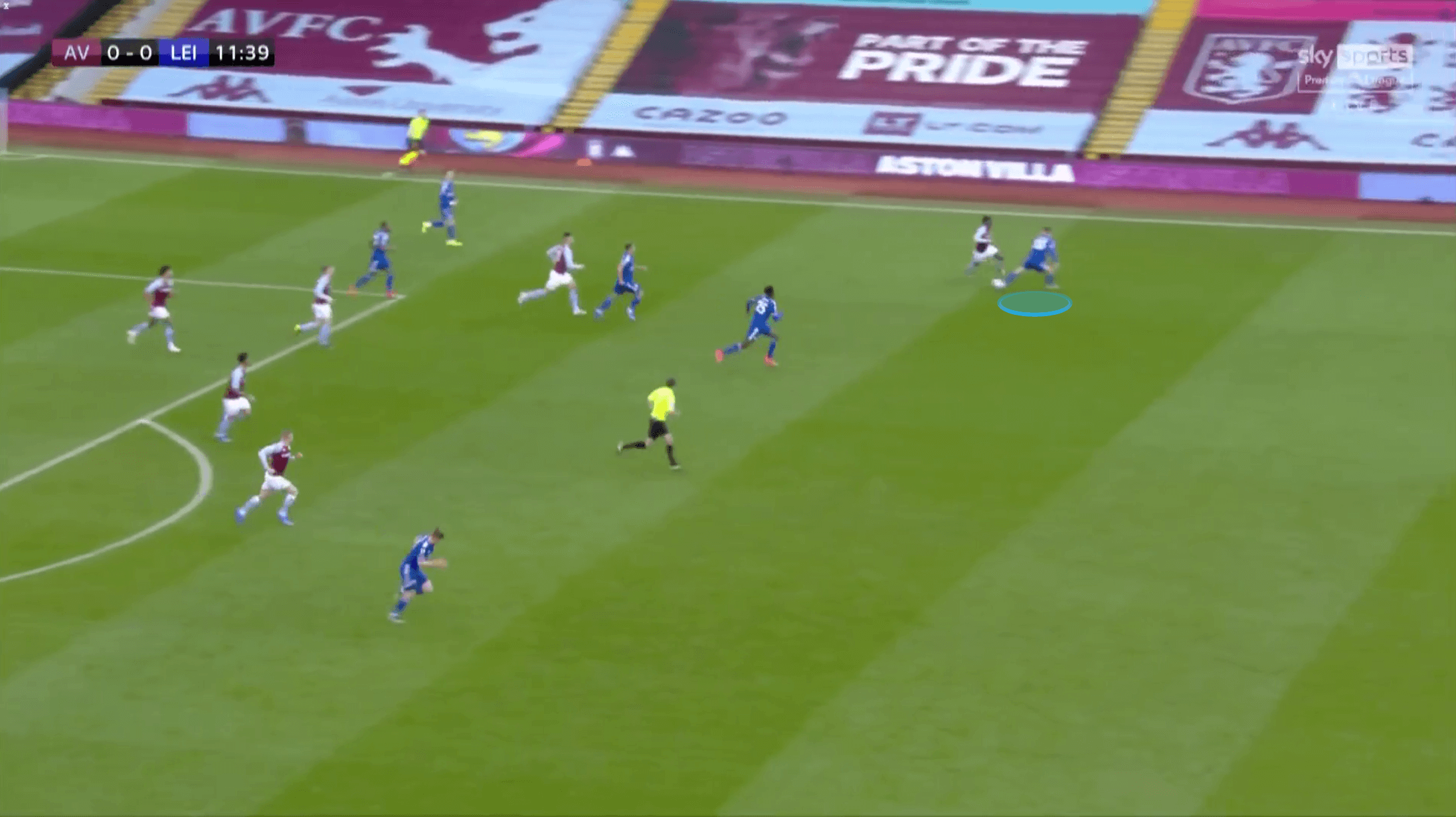
Conclusion
It still feels too early for Thomas to make the step up to the senior England team. However, realistically, it isn’t far away and he will fancy his chances of pushing Shaw and Chilwell for a spot in the World Cup next winter. He will need to improve his attacking output but if he can become a more regular threat from crosses, through passes, and his ability to beat players in the final third, then he will become a very well-rounded full-back. Thomas is already a left-back of the highest quality when we look at his positional discipline and defensive ability, however. He needs to just add some more quality to his attacking performance.

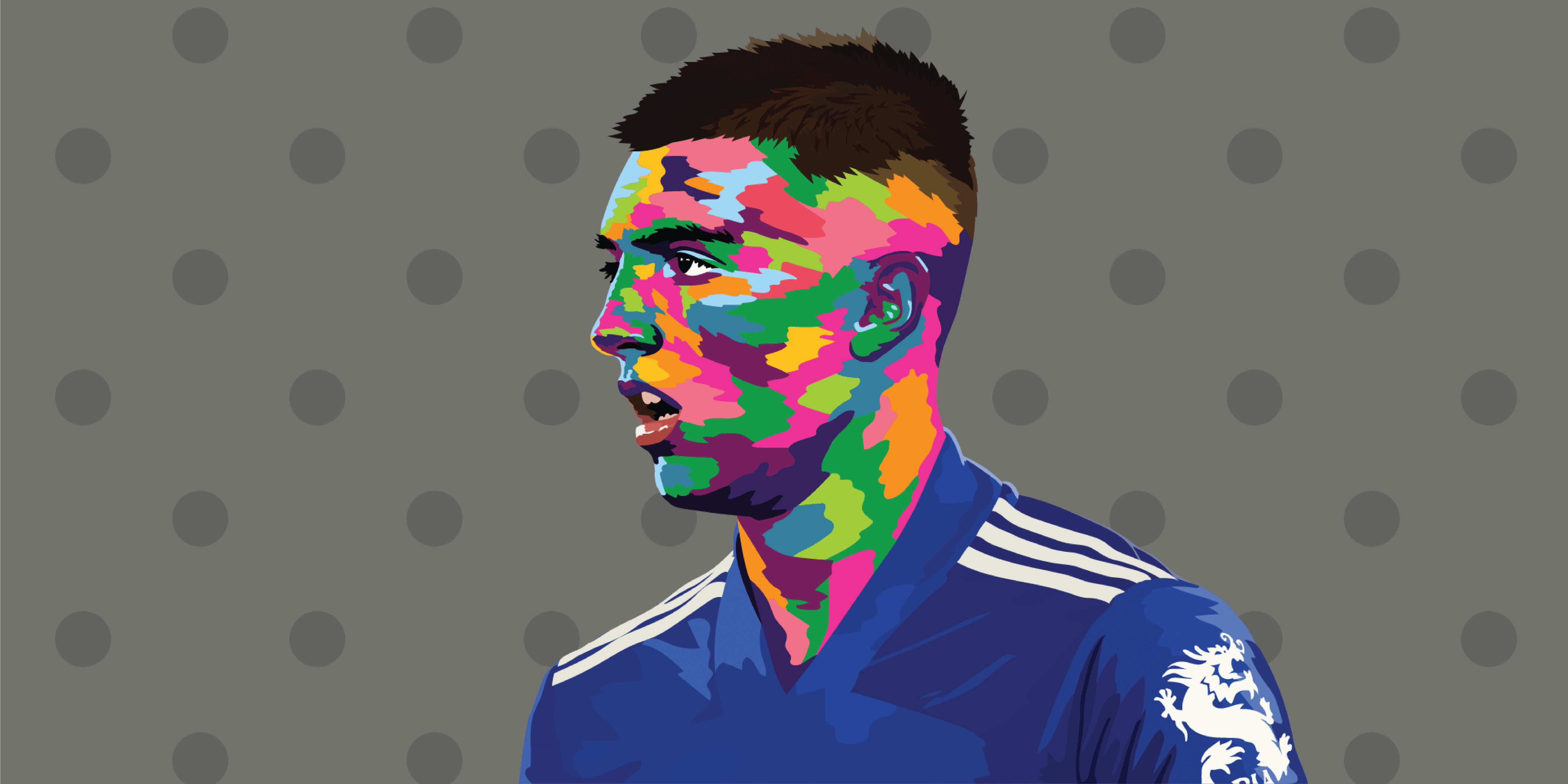
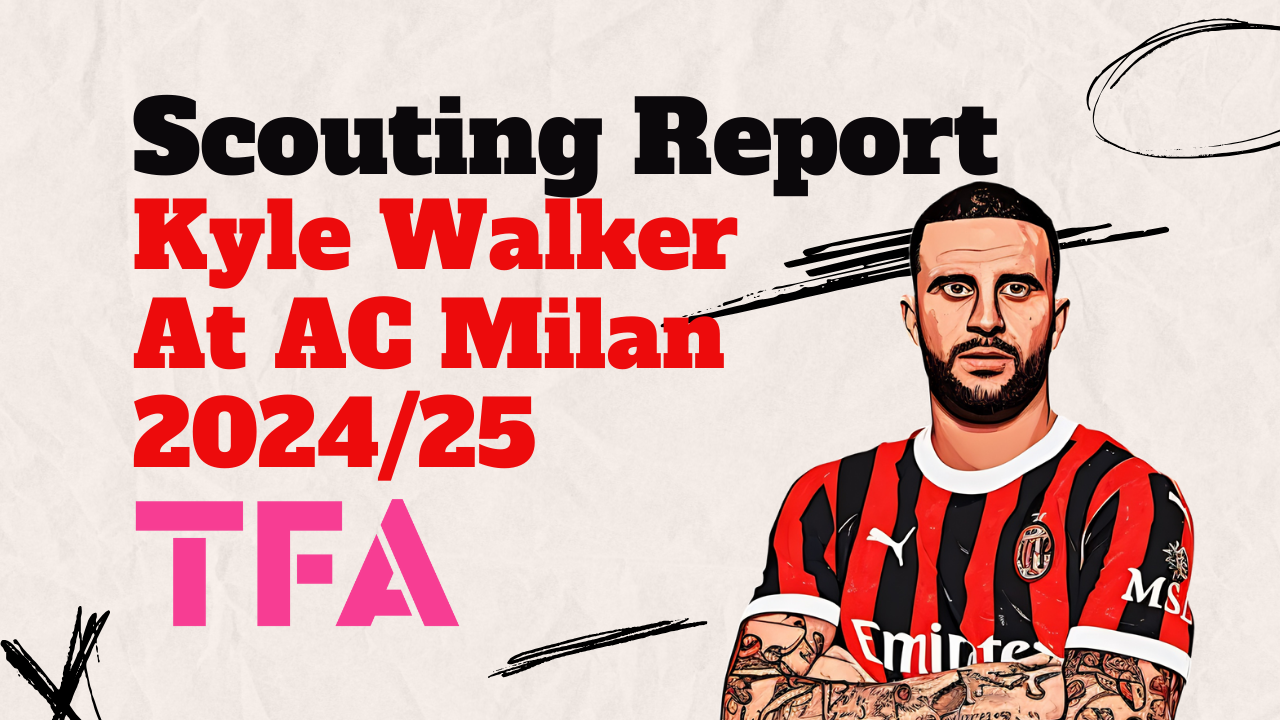
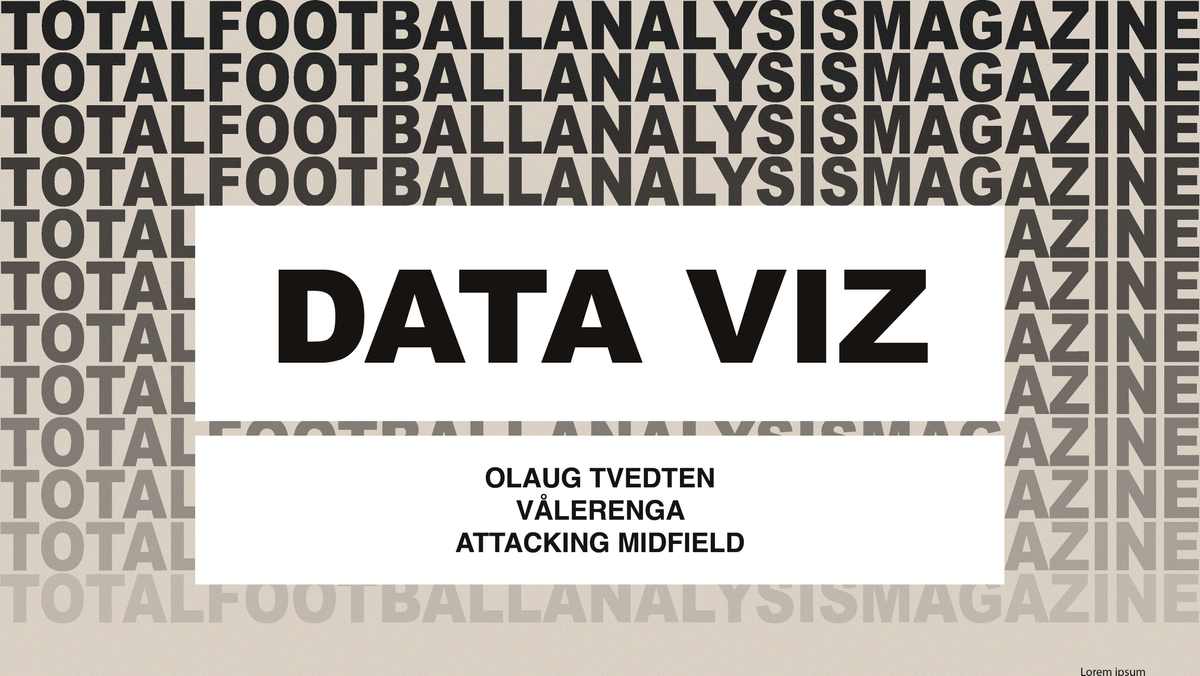

Comments